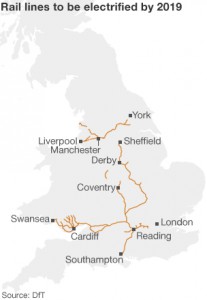
More than £9 billion of growth-boosting railway upgrades across England and Wales – representing faster journey times, more reliable services and capacity for 140,000 extra daily commutes by train – have been announced.
The full £9.4bn programme of improvements to the rail network published today will meet the needs of intercity passengers, commuters and freight up to the end of this decade while the Government continues to work on High Speed 2 to deliver rail capacity for the British economy in the decades to come.
This “High Level Output Specification” programme for 2014-2019 will be discussed at today’s meeting of the Cabinet which the Prime Minister and Deputy Prime Minister will hold outside London.
Crossrail, Thameslink, and electrification between London and Cardiff, Manchester to Liverpool and Preston, and across the Pennines, are among £5.2bn of projects already committed to during 2014-2019. New schemes totalling £4.2bn unveiled today include:
“Upgrades to stations and tracks creating enough capacity around cities for an additional 140,000 daily rail commutes at peak times. In addition to Crossrail and Thameslink, announced previously, today’s enhancements – such as the £350m lengthening of platforms at London Waterloo station – will provide capacity for 120,000 more daily commutes in and out of London and 20,100 extra daily commutes across Birmingham, Leeds, Manchester and other cities.
“Faster journeys and more train capacity from £240m of improvements along the East Coast Main Line from the North East down through Yorkshire, Lincolnshire and Cambridgeshire to London.
“The creation of a high-capacity “electric spine” running from Yorkshire and the West Midlands to South Coast ports allowing more reliable electric trains to cut journey times and boost capacity for passengers and freight. This comprises: an £800m electrification and upgrade from Sheffield – through Nottingham, Derby and Leicester – to Bedford, completing the full electrification of the Midland Main Line out of London St Pancras; and electrification of the lines from Nuneaton and Bedford to Oxford, Reading, Basingstoke and Southampton.
“The landmark decision to take electric rail beyond Cardiff to Swansea, completing the full electrification of the Great Western Main Line out of London Paddington at a total cost of more than £600m, and electrifying the Welsh Valley lines, including Ebbw Vale, Maesteg and the Vale of Glamorgan. These will give two-thirds of the Welsh population access to new fleets of electric trains helping to generate Welsh jobs and growth by slashing journey times and boosting passenger and freight capacity.
“Completion in full of the “Northern Hub” cluster of rail enhancements with the approval of £322m of outstanding track and capacity upgrades across Manchester city centre, Manchester Airport and across to Liverpool. These are in addition to £477m of Northern Hub schemes already approved across the North of England such as electrification of the North Trans Pennine route between York and Manchester.
“A new £500m rail link between the Great Western Main Line and Heathrow allowing direct services to the airport for passengers from the West Country, the Thames Valley and Wales.
The HLOS package will be funded in part from fare rises already announced in 2010 and also from the substantial efficiency savings which projects like electrification will have on the long term operating costs of the railways.
Deputy Prime Minister Nick Clegg said:
“This is the biggest expansion in railways in over 150 years, with more than £9bn of investment across the country.
“Whilst we inherited a deficit greater than any in our nation’s peacetime history, we knew that we had to give the country the boost it needs, to build great railways and make journeys better for the millions of hard working people who use the train every day.
“The ‘Electric Spine’ will make a significant difference for passengers linking London, the Midlands and Yorkshire in a much more efficient rail line, connecting the South and North more effectively than ever before.
“As someone who cares deeply about the environment, the opportunity to dramatically expand rail, a greener form of transport than aviation or road is very exciting indeed. This investment will help people to choose trains over cars, reduce carbon emissions and provide a rail system that is faster, more reliable and greener.”


